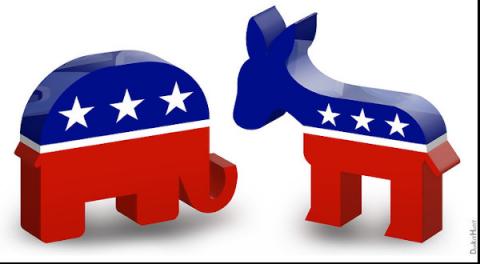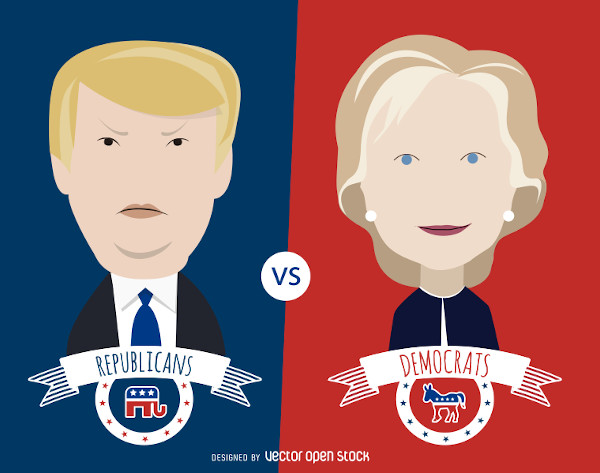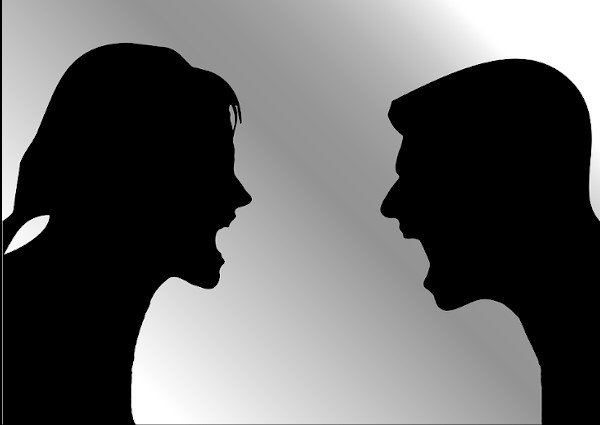21st Century Political Discourse: Let’s Agree to Disagree

In recent decades, the American electorate appears to be in a vast conflagration of hyper-partisan politics. A May 2021 paper from the World Inequality Lab explains that since 1948, Western democracies have seen educated elites usurp power over liberal-leaning parties and financial elites doing the same for right-leaning parties. The authors argue these multi-elite party systems avoid policies that seek to improve the material conditions of the people and amplify cultural issues that divide the electorate such as green and anti-immigration movements.
As a result, contemporary U.S. voters have largely bifurcated into distinct political tribes that look to party affiliation rather than policy preferences to inform their electoral participation. In fact, a 2019 study from Michael Barber and Jeremy C. Pope in the American Political Science Review found that low-knowledge respondents, strong Republicans, Donald Trump- approving respondents, and self-described conservatives who voted for Trump, approved of whatever he said, including his support for some liberal policy measures, because they are loyal to their party not policy.
As social identity theorists have long predicted, party polarization results in factionalism: Party adherents’ political identity is limited to lauding and defending the in-group while touting hostile opinions about the out-groups. For example, a 2017 study from Gregory A. Huber and Neil Malhotra in The Journal of Politics about online dating found that an individual’s party affiliation is a decisive factor in choosing a dating partner. Similarly, a 2020 Pew Research poll found that seven out of 10 self-identified Democrats would not consider dating a person who voted for Trump. Shanto Iyengar and Sean J. Westwood explain that partisan divides can persist because “unlike race, gender and other social divides where group-related attitudes and behaviors are constrained by social norms, there are no corresponding pressures to temper disapproval of political opponents.”

In addition to polling, the malignancy of hyper-partisan politics appears in voting patterns. Since the 1990s, studies have found that Americans are drifting further and further to the political extremes. For example, a 2021 Pew Research study found that before the 1990s, it was common for voters to select presidential candidates and U.S. Senators from different parties in a single electoral year. However, since then it has become an almost nonexistent practice in American politics as voters vote uniformly with one party or another. Two years earlier, Pew concluded that “the level of division and animosity – including negative sentiments among partisans toward the members of the opposing party – has only deepened.”
Scholars argue that media help ossify the hyper-partisan divisions. This includes the news media, social media, and entertainment media, from Madison Avenue to Netflix, Hollywood to Silicon Valley, and an endless array of television and online streaming-type programs. In terms of both digital and legacy media, a handful of corporations dominate the media that Americans use. Rather than unite the people in a shared experience conducive to constructive dialogue, this corporate-dominated, private for-profit media in the U.S. has sought to divide the electorate.
In Hate Inc., journalist Matt Taibbi notes that legacy media – such as network news, cable news, and the newspapers – abandoned the Cold War framing of news stories, which pitted the American audience against the communists, for a partisan framing that pits Democrats against Republicans. This style of reporting deliberately stokes hyper-partisan fears by characterizing the opposition party and their supporters as villainous as the communists were reported to be in the mid-20th century. This milquetoast approach to reporting was borrowed from pro-wrestling, which for decades had profited from confirming audience desires to be on the side of the “good guy,” by mimicking an ultimate villain, a foil, who is the “bad guy.” This corrosive approach to the electorate was made worse by the advent of internet platforms such as Google, Facebook, Instagram, TikTok, and Twitter, which all rely on a business model of data collection and analysis that feeds users information that confirms their views rather than challenges them, making users further afraid of the “other side.”

Despite the widespread use of so-called social media, the increased polarization of the U.S. reveals Americans choose to avoid or silence their political rivals rather than engage in democratic dialogue. We see it in news media with people such as Brian Seltzer of CNN arguing that de-platforming Donald Trump is acceptable because “reducing a liar’s reach is not the same as censoring freedom of speech;” Fox News Channel’s Sean Hannity hosting and talking over New York Mayor Bill de Blasio for over 40 minutes; in 2020, CNBC’s Rick Santelli launching a shouting match on air where he yelled over others about COVID-19 restrictions; and that same year, a journalist and a Trump campaign official yelling at each other about the official vote count from the 2020 Presidential Election on Fox News Channel.
The impulse to silence rather than engage in dialogue with ideological enemies runs rampant in electoral politics, such as the September 2020 presidential debate that saw Trump interrupt his Democratic challenger Joe Biden over 50 times; and Biden asking Trump, “Will you shut up, man?” at that very same debate.
In fact, Americans question whether dialogue with other Americans, a necessity for the cultivation of social capital, is even worth their time. In 2020, Bahman Fozouni, a professor emeritus in the Political Science Department at California State University, Sacramento, asked, “Should we find ourselves in the company of the Trumpies, does it make sense to engage them in a political conversation?” A year earlier, filmmaker Michael Moore argued that liberals have “all tried at Thanksgiving dinner to convince the conservative brother-in-law of the wrongness of his ways, but he’s three years deep into pro-Trump. He’s lost. And we have to kind of give up on them, because we don’t have the time.” However, we’re arguing here that maybe we need to take the time, and make an opportunity to engage in critical discourse through constructive communication rather than write people off because it seems easier. It is one thing to want change, but it is quite another to do the difficult work required to change minds and build alliances.
As conservative professor of jurisprudence and director of the James Madison Program in American Ideals and Institutions at Princeton University, Robert P. George explains, this is a death knell for a democracy because “you cannot run a democratic republic if people are not willing to engage each other and learn from each other and treat each other respectfully—not just out of politeness but out of a desire to advance the common good.”

Similarly, noted civil rights activist and former Harvard and Princeton scholar Cornel West reminds us that civil discourse has been lost to destructive conflict because of the eclipse of integrity and honesty and decency, and the normalization of corruption, deceit, and mendacity. It’s all about manipulating your political opponents to diminish them and show that they have nothing to say or contribute. People no longer have dialogue. It’s all monologue.
The threat destructive dialogue poses to democracy has shaped recent discourses about civil war. A civil war refers to “an armed conflict between citizens of the same country.” In 2019, U.S. Attorney Joseph diGenova, a Fox News regular, declared that “We are in a civil war.” He recognized the connection between civil war and dialogue, noting that “the suggestion that there’s ever going to be civil discourse in this country for the foreseeable future is over ... It’s going to be total war.”
In the 19th century, the U.S. experienced a civil war over issues relating to slavery. A civil war is anathema to a democracy because it illustrates that the democratic institutions can no longer politically and peaceably manage conflicts. Yet, by early 2021, over half of Americans surveyed, up from just under one-third three years previous, believed America was heading for a civil war in their lifetime. Similarly, Rep. Steve King (R- Iowa) posted a meme warning that states which typically vote for his party have “8 trillion bullets” in the event of civil war. Whether or not a civil war occurs is immaterial; what does matter is that a substantial portion of Americans are so polarized that civil war is even a consideration.
Excerpted with permission from Let’s Agree to Disagree: A Critical Thinking Guide to Communication, Conflict Management, and Critical Media Literacy by Nolan Higdon and Mickey Huff (Routledge).
Author Bios:
Nolan Higdon is a lecturer at Merrill College and the Education Department at University of California, Santa Cruz. Higdon’s areas of concentration include digital culture, news media history, and critical media literacy. Higdon is a founding member of the Critical Media Literacy Conference of the Americas. He sits on the boards of the Action Coalition for Media Education (ACME) and Northwest Alliance For Alternative Media And Education. His most recent publications include The Anatomy of Fake News: A Critical News Literacy Education (2020) and The Podcaster’s Dilemma: Decolonizing Podcasters in the Era of Surveillance Capitalism (2021). He is a longtime contributor to Project Censored’s annual book, Censored. In addition, he has been a contributor to Truthout and Counter-Punch; a source of expertise for numerous news outlets, including The New York Times, CNBC, and San Francisco Chronicle.
Mickey Huff is the director of Project Censored and president of the nonprofit Media Freedom Foundation. To date, he has co-edited 13 editions of the Project’s yearbook, including most recently Project Censored’s State of the Free Press (2022), with Andy Lee Roth. He is also co-author with Nolan Higdon, of Unites States of Distraction: Media Manipulations in Post-Truth America (and what we can do about it) (2019). Huff received the Beverly Kees Educator Award as part of the 2019 James Madison Freedom of Information Award from the Society of Professional Journalists, Northern California. He is professor of social science, history, and journalism at Diablo Valley College, where he co-chairs the history program and is chair of the Journalism Department. Huff is executive producer and host of The Project Censored Show, a weekly syndicated public affairs program that airs across the U.S. on Pacifica Radio. Learn more at projectcensored.org.
Highbrow Magazine
Image Sources:
--Donkey Hote (Flickr, Creative Commons)
--Vector Open Stock (Wikimedia, Creative Commons)
--Routledge
--Pixabay (Creative Commons)





























































































































































































































































































































